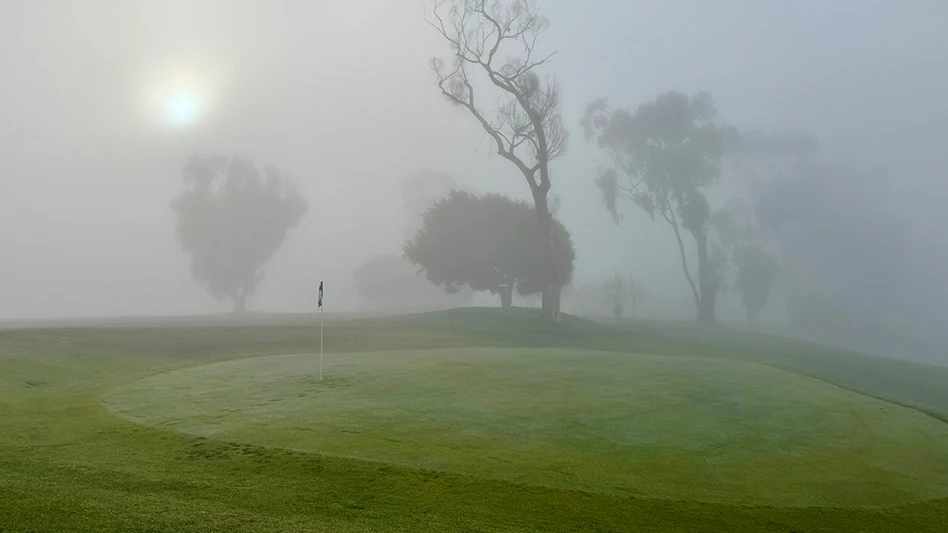
Evan Schiller
The carnival left. The crowds departed. The TV cameras and the hospitality tents are gone in the aftermath of the KPMG Women’s PGA Championship.
But Baltusrol Golf Club’s magnificent Lower Course remains in all its splendor for the members and their guests to savor.
That’s just fine with Baltusrol director of grounds Greg Boring. The renovation of the Lower Course, which was completed two years ago, was undertaken with the members in mind.
“It wasn’t to make it more difficult for majors and things like that,” Boring says. “It was to go back to what the intention of A.W. Tillinghast was. And let’s face it, the vision that he had when he built the place, that really wasn’t what was on the ground anymore.”
Architect Gil Hanse was charged with restoring Tillinghast’s vision. But it was Boring and his team who were responsible for upgrading the Lower Course’s infrastructure.
Priority No. 1 was upgrading the course’s ability to manage water. In July of 2019, Boring’s first season at Baltusrol, several fairways were completely flooded.
“We knew we had to revamp the drainage system,” he says. “We installed a brand-new irrigation system and pump station. We went from 1,800 gallons a minute to 4,500 gallons a minute.”
The club also rebuilt greens and tees and cored out the approach areas. The goal was to help the course play similarly to what Tillinghast intended when the layout opened in 1922.
“One of the things that A.W. Tillinghast preached in his early writings about the club was that it was meant to play firm and fast,” Boring says. “We cored out the approaches, so the approaches acted more like the green surfaces and the approaches are really tight, they’re really fast, they’re really firm. If you hit the approach, it’s going to act like it hit the green.”
To minimize the possibility of future flooding problems, the crew installed a PrecisionAire system underneath every green, including the practice green. The putting surfaces themselves were expanded.
“We were able to restore the corners of the greens that had been lost over time,” Boring says. “We expanded the greens on average to about 2,000 square feet per green so we were able to pick up a huge amount of hole locations that didn’t exist for some time.
“And, where we had evidence that a green was altered completely, we made that change as well, and we took it back to and restored it to what Tillinghast had. The seventh green was changed before the 1954 Open by Robert Trent Jones. We put that green complex back to its original A.W. Tillinghast roots.
“Our eighth green complex kind of sits back in a corner. We put the fans in an underground vault. They’re on an electric lift and they raise and lower as they’re needed. That way the members aren’t seeing the fans sitting next to the green if the fans aren’t being utilized.”
Boring says the steps he and his crew have taken to make the Lower Course less vulnerable to flooding are paying off on a day-to-day basis.
“I don’t think we’ve pulled a squeegee or bunker pump or any pump on the lower since 2019,” he says. “Those days are hopefully behind us for quite some time. The USGA greens, we’ve got to fertilize them a little bit more. But I can tell you, it’s just so much easier getting the firmness that we want, getting the green speeds that we want and there is a lot less we have to address with the greens to achieve our standards on a daily basis.”
Boring has additional steps to enhance his water-conservation efforts and reduce disease pressures.
“One of the things we did, we added about 55 acres of rough with a variety of turf-type tall fescue,” he says. “Before, we were having to spray for summer patch in the rough with the Kentucky bluegrass. Now, our rough is pretty much bulletproof. We’re putting a lot less water out in the rough, a lot less chemicals. So, that’s been a huge benefit of having all that new grass.”
Boring is appreciative of how his members have supported not only the renovation of the Lower Course, but the planned renovation of Baltusrol’s Upper Course, which is set to begin in 2024.
Rick Woelfel is a Philadelphia-based writer and senior Golf Course Industry contributor.
Get curated news on YOUR industry.
Enter your email to receive our newsletters.
Latest from Golf Course Industry
- Beyond the Page 65: New faces on the back page
- From the publisher’s pen: New? No way!
- Indiana course upgrades range with synthetic ‘bunkers’
- Monterey Peninsula CC Shore Course renovation almost finished
- KemperSports and Touchstone Golf announce partnership
- PBI-Gordon Company hires marketing manager Jared Hoyle
- Mountain Sky Guest Ranch announces bunker enhancement project
- GCSAA names Joshua Tapp director of environmental programs





